Oracle 1z0-054 Exam Practice Questions (P. 1)
- Full Access (192 questions)
- Six months of Premium Access
- Access to one million comments
- Seamless ChatGPT Integration
- Ability to download PDF files
- Anki Flashcard files for revision
- No Captcha & No AdSense
- Advanced Exam Configuration
Question #1
After running SQL Performance Analyzer (SPA), you observe a few regressed SQL statements in the SPA output. Identify the two actions that you would suggest for these regressed SQL statements. (Choose two.)
- ARunning SQL Access Advisor
- BAdding them to SQL Plan Baseline
- CSubmitting them to SQL Tuning Advisor
- DRunning Automatic Database Diagnostic Monitor (ADDM)
Correct Answer:
BC
BC
send
light_mode
delete
Question #2
View the Exhibit exhibit1 to examine the series of SQL commands and parameter settings.
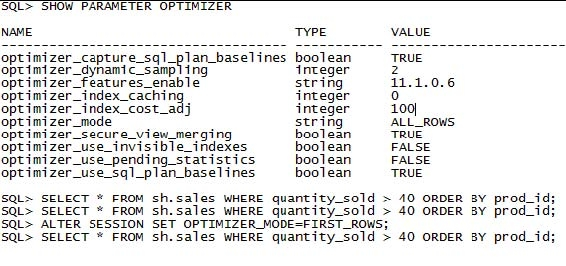
View the Exhibit exhibit2 to examine the plans available in the SQL plan baseline.
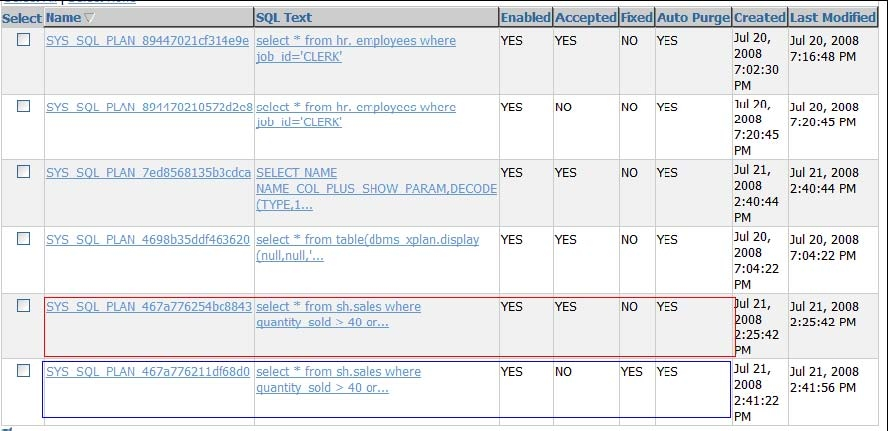
The first plan (in red) is created when OPTIMIZER_MODE is set to ALL_ROWS and the second plan (in blue) is created when OPTIMIZER_MODE is set to
FIRST_ROWS.Which SQL plan baseline would be used if the SQL query in exhibit1 is executed again when the value of OPTIMIZER_MODE is set to
FIRST_ROWS?

View the Exhibit exhibit2 to examine the plans available in the SQL plan baseline.

The first plan (in red) is created when OPTIMIZER_MODE is set to ALL_ROWS and the second plan (in blue) is created when OPTIMIZER_MODE is set to
FIRST_ROWS.Which SQL plan baseline would be used if the SQL query in exhibit1 is executed again when the value of OPTIMIZER_MODE is set to
FIRST_ROWS?
- Athe second plan, because it is a fixed plan
- Bthe first plan, because it is an accepted plan
- Cthe second plan, because it is the latest generated plan in FIRST_ROW mode
- DA new plan, because the second plan in FIRST_ROW mode is not an accepted plan
Correct Answer:
B
B
send
light_mode
delete
Question #3
You work as a DBA for a company and you have the responsibility of managing one of its online transaction processing (OLTP) systems. The database encountered performance-related problems and you generated an Automatic Workload Repository (AWR) report to investigate it further. View the Exhibits and examine the AWR report.
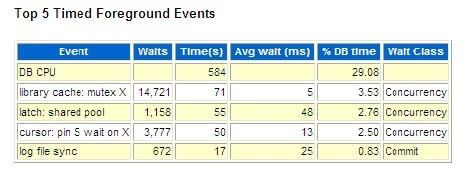
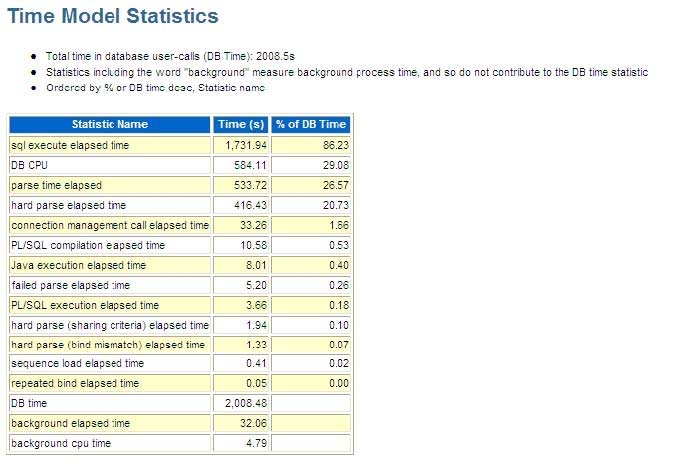
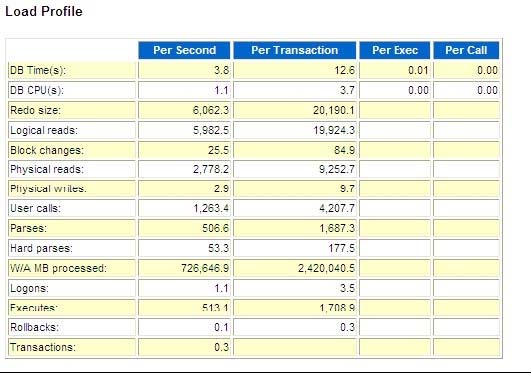
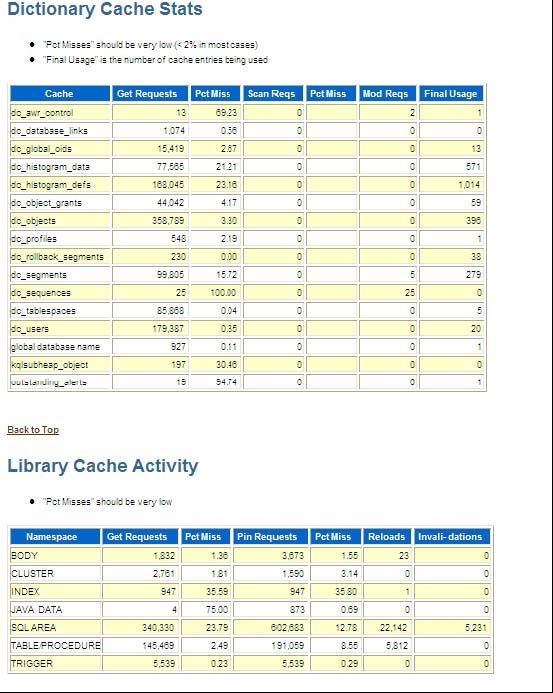
What could be the problem in this database?




What could be the problem in this database?
- AJava pool is not configured.
- BThe CPU in the system is slow.
- CThe shared pool size is inadequate.
- DThe database buffer cache is inadequate.
- EThe OPEN_CURSORS parameter is set to a small value.
Correct Answer:
C
C
send
light_mode
delete
Question #4
You are working on an online transaction processing (OLTP) system. You detected free buffer waits events for your database instance running in a machine that has multiple CPUs. You increased the database buffer cache size as the first step. After a few hours of work on the database, further investigation shows that the same event is being recorded. What would be your next step to avoid this event in future?
- ADecrease the value of the DBWR_IO_SLAVES parameter.
- BSet the USE_INDIRECT_DATA_BUFFERS parameter to TRUE.
- CIncrease the value of the DB_WRITER_PROCESSES parameter.
- DIncrease the value of the DB_FILE_MULTIBLOCK_READ_COUNT parameter.
Correct Answer:
C
C
send
light_mode
delete
Question #5
You are working on a development database that was upgraded to Oracle Database 11g from Oracle Database 9i. An ADDM finding in this database says that the shared pool is inadequately sized, as shown in the Exhibit.

You diagnosed that this is due to different kinds of workloads and this occurs only during peak hours. You tried to resize this by shrinking the database buffer cache but that caused inadequate buffer cache problems. The following are the related parameter settings:
SQL> show parameter sga -
NAME TYPE VALUE -
------------------------------ --------------- ----------------- lock_sga boolean FALSE pre_page_sga boolean FALSE sga_max_size big integer 300M sga_target big integer 0
SQL> show parameter target -
NAME TYPE VALUE -
------------------------------ --------------- -----------------
.....
fast_start_mttr_target integer 0
memory_max_target big integer 0
memory_target big integer 0
pga_aggregate_target big integer 100M
sga_target big integer 0
You want to balance the memory between the System Global Area (SGA) components within SGA without affecting the size of the Program Global Area (PGA).
Which action would solve this problem?

You diagnosed that this is due to different kinds of workloads and this occurs only during peak hours. You tried to resize this by shrinking the database buffer cache but that caused inadequate buffer cache problems. The following are the related parameter settings:
SQL> show parameter sga -
NAME TYPE VALUE -
------------------------------ --------------- ----------------- lock_sga boolean FALSE pre_page_sga boolean FALSE sga_max_size big integer 300M sga_target big integer 0
SQL> show parameter target -
NAME TYPE VALUE -
------------------------------ --------------- -----------------
.....
fast_start_mttr_target integer 0
memory_max_target big integer 0
memory_target big integer 0
pga_aggregate_target big integer 100M
sga_target big integer 0
You want to balance the memory between the System Global Area (SGA) components within SGA without affecting the size of the Program Global Area (PGA).
Which action would solve this problem?
- ASet the SGA_TARGET parameter to 300M.
- BSet the SGA_MAX_SIZE parameter to 400M.
- CSet the MEMORY_TARGET parameter to 100M.
- DSet the MEMORY_MAX_TARGET parameter to 300M.
Correct Answer:
A
A
send
light_mode
delete
All Pages
